
Factors affecting language acquisition in the digital switchTran Quang MinhHong Bang International University, VietnamABSTRACTThese aspects motivational and affective effects of language learning have largely been neglected by researchers despite having a monumental influence on the acquisition of language. For this paper, I would like to address the roles of motivation and affective effects on second language acquisition by addressing the following questions: 1) What are the roles of motivation and affective effects in language acquisition? 2) What are the triggers of these effects and how they affect students learning process? 3) What can teachers do to raise or alleviate these effects for the betterment of language learning? For the first question, this paper will explore the role of motivation in language acquisition by using citations from Celce-Murcia, Brinton, & Snow (2014), Meniado (2019), Dörnyei, Z. (1990), etc. To answer the second question, the paper will discuss the prompts and input for various affective effects and their influence on students through Garrett & Young (2009). The effects on language would also be discussed using study by Pavlenko & Dewaele (2004), Dewaele (2005), Tran, Thu H. (2013) etc. For the final question, the paper will provide suggestions and approaches to address the motivational and affective elements of language acquisition from Celce-Murcia, Brinton, & Snow (2014) as well as tasks and strategies to raise motivation from both teachers and students Dörnyei (2003).Keywords: motivations, second language acquisition, affectproficient English speakers increases to accom-modate the volume of trade and administrave tasks conducted daily. Many research and experiments in the past tried to discuss and explain different elements involved in the language acquision process, many teaching methods and approaches were discussed and experimented to determine the appropriate and effecve soluon to teaching language. Kramsch (2013) [1] revealed that some students' learning experience varied as some described their language learning process as “traveling to a different place” while others compared their experience to “undergoing a painful medical procedure”. Garre & Young (2009) [2] pointed out that affecve reacons to learning provide informaon about disnct learning behaviors and students' state of mind during the language lessons. Despite the instrumental impacts movaonal elements and affecve effect have on students, very few studies focused on the influence of movaonal and affecve effects (feelings, emoons, experience, etc.) on language learning and second language acquision (SLA). Thus, the purpose of this paper is to disnguish the funcon of movaon and affecve effects, their triggers and influence on learners and how can teachers manipulate these variables for the beerment of the students while adapng new technologies in their lessons by addressing the following quesons:1) What are “movaon” and “affect” in language learning?2) What are the roles of movaon and affecve effects in language acquision?3) What are the triggers of these effects and how they affect students learning process?4) What can teachers do to raise or alleviate these effects for the beerment of language learning?2. WHAT ARE “MOTIVATION” AND “AFFECT” IN LANGUAGE LEARNING?The term “movaon” is used commonly by both teachers and students when referring to their success or failure in language learning ad are usually taken by granted. The ambiguity of the term and people's vague percepon of movaon 61Hong Bang Internaonal University Journal of ScienceISSN: 2615 - 9686Hong Bang Internaonal University Journal of Science - Vol.4 - June 2023: 61-68DOI: hps://doi.org/10.59294/HIUJS.VOL.4.2023.387Corresponding Author: MS. Tran Quang Minh Email: minhtq@hiu.vn1. INTRODUCTION

62Hong Bang Internaonal University Journal of ScienceISSN: 2615 - 9686Hong Bang Internaonal University Journal of Science - Vol.4 - June 2023: 61-68go against what it is defined in psychology and applied linguisc fields. The term “movaon” has been commonly divided into integrave (intrinsic) movaon and instrumental (extrinsic) movaon. Integrave or intrinsic movaon refers to learners' desire to integrate with the target culture (i.e. geng married or immigraon) while students' instrumental (extrinsic) movaon is the needs of using second languages to achieve certain goals (i.e. geng promoted or applying to universies). All of these factors influence and create different learning behaviors among students. Tran (2013) [3] looked at movaon from different viewpoints, movaon could be seen as a “product of external forces through reinforcement”, derived from behavioral responses or conscious choices humans made on their own accord. Another perspecve is that “movaon is based upon the premise that each person is movated in a different way” (Williams & Burden, 1997) [4]Affecve effects refer to the emoonal responses which students experience throughout the learning process. These were largely neglected and omied by psychologists during most of the last century as “Emoon was at the opposite end from reason, easily the finest human ability, and reason was presumed to be enrely independent from emoon” (Damasio, 1999, cited in Celce-Murcia, Brinton & Snow, 2014)[5]. Affecve appraisal of smulus is believed to be the center of cognion and drives our decision-making processes. In other words, posive experience encourages people to seek for the same smuli in the future while unpleasant ones result in avoidance, by experiencing the world themselves, people develop their own preference and avoidance for different smulaons. 3. WHAT ARE THE ROLES OF “MOTIVATION” AND “AFFECTIVE EFFECTS” IN LANGUAGE ACQUISITION?To the students, the classroom is an interacve community of people, and they would go to great lengths to preserve their status within that community. A situaon perceived as threatening by the students to their membership and status in the classroom can hamper their willingness to create and preserve social affiliaons. In spite of this, not many studies of SLA have been done to address student's emoons and feelings for their language learning experience. Bailey's experiment on students' anxiety and compeveness in 1983 revealed that peer pressure and comparisons between themselves and others resulted in the students considering themselves as inferior. Bailey also pointed out that her desire for acknow-ledgment from their peers caused more stress and anxiety than her fear for the teacher's approval. This had a more severe effect when she compared herself to those who she thought was more proficient that her in language classes.Pavlenko and Dewaele (2004) [6] invesgated the influence of affecve effects in bilinguals and discovered that to express feelings, they would choose the language which they shared the strongest emoonal bond. Dewaele also commented in this arcle that focusing on the affect elements could encourage new teaching materials and approaches that emphasized on “communicaon of emoon” to promote sociocultural competence and overall language acquision.Regarding movaon in SLA, different studies examined and seemed to have different takes on the importance of movaon. It seems evident that movaonal students are more likely to enroll in classes. Dörnyei's (1990) [7] measured movaonal elements against Course Achie-vement, Course Aendance, Further Enrollment and Extracurricular Language Use (i.e. learners' self-report on the effort they invested to communicate using the target language) to shed light on how they were affected by movaon. Despite the low correlaons, he discovered many disnct and significant trends. Course Achie-vement and Further Enrolment were reported to have a highly posive correlaon only with Need for Achievement, making it the main element of movaon in language learning. Dörnyei's explanaon for this was that the influences mainly derived from teachers' personalies and classroom interacons despite the differences in students' movaons.As stated by Dörnyei (2005) [8]:” …movaon provides the primarily impetus to iniate L2 learning and later the driving force to sustain the long and oen tedious learning process; indeed, all the other factors involved in SLA presuppose movaon to some extent”. This, in other words,

63Hong Bang Internaonal University Journal of ScienceISSN: 2615 - 9686Hong Bang Internaonal University Journal of Science - Vol.4 - June 2023: 61-68suggested that many students aain a second language despite the differences in aptude, students lacking movaon even though they possess excellent academic performance and results would fail to aain long-term goals. Zareian & Jodaei (2015) [9] pointed out that movaon can compensate for students' learning abilies in second language learning. 4. WHAT ARE THE TRIGGERS OF THESE EFFECTS AND HOW THEY AFFECT STUDENTS LEARNING PROCESS?Garre & Young's (2009) [2] study on Garre's own language learning experience to give explanaons for how affects were formed among students. The authors also revealed the topics that generated the highest affecve response rates, which were language awareness, teacher voice, social relaons and culture learning. In Garre's case, it is noceable that social relaon and language awareness accounted for the highest response rate for negave comments. She remarked that she felt compeve and “threaten” when comparing herself to other students, as the class went on, she felt more and more insecure when speaking in front of her peers. Unl the end of the course, she sll felt inferior when comparing herself to other students and was sll not comfortable when communicang in the target language despite her success on quizzes and tests. It is also interesng that Garre felt more stressed and was more inmidated by classroom relaons due to her fear of speaking in class or pair/group work as she did not feel comfortable when comparing herself to others who she considered higher in proficiency. This goes in line with Bailey's, 1983, cited in Celce-Murcia, Brinton & Snow, 2014) [5] commented on how students' self-awareness of their own learning community can have detriment effects on their self-images and emoons towards the language learning experience and language acquision. Movaon in SLA is an umbrella and encompass many aspects of psychology and applied linguisc. Dörnyei (2001) [10] proposed a few aspects of movaon including social movaon and movaon and self-determinaon theory. Social movaon, comprised sources of influence derived from sociocultural aspects rather than the individuals. This means that the needs of the community or the community itself influence the mindset and “movaon” of the person. Another prevalent theory as proposed by self-determinaon theory which includes the disncve differences between intrinsic and extrinsic movaons. This theory places regulators on the two types of movaon to determine how it changes from intrinsic to extrinsic. As a result, five categories were idenfied including:“…external regulaon (i.e., movaon coming enrely from external sources such as rewards or threats); introjected regulaon (i.e. externally imposed rules that students accept as norms they should following order not to feel guilty); idenfied regulaon (i.e., engaging in an acvity because the individual highly values it and sees its usefulness); integrated regulaon (i.e., involving choiceful behavior that is fully assimilated with the individual's other values, needs, and identy); and pure regulaon” (Dörnyei, 2001) [10].The division between intrinsic and extrinsic movaon can become blurry at mes, learners may have “mixed moves” (Zareian & Jodaei, 2015) [9] meaning that he/she has both types of movaon at the same me. Zareian & Jodaei's proposal for mixed movaon was backed up by Dörnyei's (2005) [8] noon of various types of movaon are connuies of one another. Ryan & Deci (2000, cited in Celce-Murcia, Brinton & Snow, 2014)[5] came up with a model to explain the interacon between the types of movaon, one end of the two extremes is amovaon or the absent of “self-determinaon” (Levesque, Copeland & Sutcliffe, 2008, cited in Seyadi, Mahpul & Wicaksono, 2019) [11] and at the other end is intrinsic movaon with extrinsic movaon floang in the middle. Ryan & Deci (2000a, cited in Celce-Murcia, Brinton & Snow, 2014) [5] based their claim on the argument that amovaon people's acons are without any intenons and this also transfer to their behaviors. Their claim for the amovaon spectrum can be related to Gardner's (2001, cited in Celce-Murcia, Brinton & Snow, 2014) [5] idea that students may not have neither type of movaon at all. A person learning language just for the sake of learning language cannot be considered as movated enty. Pawlak's (2012) [12] experiment with 28 high school students learning English revealed great

64Hong Bang Internaonal University Journal of ScienceISSN: 2615 - 9686Hong Bang Internaonal University Journal of Science - Vol.4 - June 2023: 61-68presence of intrinsic movaon which could be observed as greater determinaon by the parcipants as the lesson went on. Extrinsic movaon also role was also significant, especially in the case of low-performing students whose top priority was passing the class. The level of movaon also translates to students' willingness to parcipate in the class which directly affected their leaning behaviors and language acquision.Dörnyei introduced goal theory, which came from educaonal psychology to further understand its effect on students and learning process Students' goals also play a key role in influencing students' learning behaviors and their acons during the learning process. He pointed out that goal and movaon correlate with each other as they both decide the concentraon and mental investment of a person in a parcular task. They also influence a person's decision to execute a task and dictate how long the individual will carry out that task as well as the approaches that person uses.5. WHAT CAN TEACHERS DO TO RAISE OR ALLEVIATE THESE EFFECTS FOR THE BETTERMENT OF LANGUAGE LEARNING?Due to the unique characteriscs and ununified definion among different fields, it would be impossible to devise a “one size fits all” approach to address movaon and affect among students. Tran (2013) [3] reviewed Williams & Burden (1997) [4] and pointed out key suggesons for classroom teachers in regard of student's movaon in Table 1. Dörnyei's (2001) [10] suggesons for teaching pracces was categorizing them in 4 groups: creang basic movaon condions, generang inial movaon, maintaining and protecng movaon and encouraging posive self-evaluaon. These are comprised in Table 2. Table 1. Williams & Burden's (1997) teaching suggesons (adapted from Tran, 2013) [12] - Teachers have to be cognizant of iniang and sustaining movaon. What iniates and what sustains movaon has not been clearly stated in the literature. - They need to discuss with learners the reason for carrying out classroom acvies. - Teachers should involve learners in making decisions related to learning the target language such as learning acvies, the methods of teaching and learning, and the needed effort for learning. - It would be wise for teachers to involve learners in seng learning goals, as learners will be able to develop feelings of control and autonomy in learning. - Teachers should recognize people as individuals by allowing them to learn in ways that are personal and significant to them. - Teachers need to help learners build up individuals' beliefs in themselves. - Teachers should help students develop internal beliefs which are the feelings that one is the cause of one's own acons and that one is in control of the results of one's acons. - Teachers need to help learners move toward a mastery-oriented style because those who are mastery oriented are oen in control of their acons and manage to find ways to enhance their performance and to succeed in an acvity. - It is of great importance for teachers to create a supporve learning environment.

65Hong Bang Internaonal University Journal of ScienceISSN: 2615 - 9686Hong Bang Internaonal University Journal of Science - Vol.4 - June 2023: 61-68Table 2. Dörnyei's (2001) movaonal teaching suggesons (Tran, 2013) [12]
Creang the basic movaonal condions
1. Teachers need to demonstrate and talk about their own enthusiasm for the course material and how it affects them personally.
2. They need to take the students' learning very seriously.
3. They need to develop a personal relaonship with their students.
4. They need to develop a collaborave relaonship with the students' parents.
5. They need to create a pleasant and supporve atmosphere in the classroom.
6. They need to promote the development of group cohesiveness.
7. They need to formulate group norms explicitly, and have them discussed and accepted by learners.
8. They need to have group norms consistently observed.
Generang inial movaon
9. Teachers can promote the students' language-related values by presenng peer role models.
10. They can raise the students' intrinsic interest in the process of second language learning.
11. They can promote 'integrave' value by encouraging a posive and open-minded disposion toward the second language, its speakers, and toward foreignness in general.
12. They can promote the students' awareness of the instrumental values associated with the knowledge of a second language.
13. They can increase the students' expectancy of success in parcular tasks and in learning in general.
14. They can increase the students' goal-orientedness by formulang explicit class goals accepted by them.
15. They can make the curriculum and the teaching materials relevant to the students.
16.
They can hclp to create realisc learner beliefs.
Maintaining and protecng movaon
17. Teachers should make learning more smulang and enjoyable by breaking the monotony of classroom events.
18. They should make learning siimulang and enjoyable for the students by increasing the aracveness of the tasks.
19. They should make learning smulang and enjoyable for the students by enlisng them as acve task parcipants.
20. They should present and administer tasks in a movang
way.
21. They should use goal-seng methods in their classroom.
22. They should use contracng methods with their students to formalize their goal commitment.
23. They should provide the students with regular experiences of success.
24. They should
build their students' confidence by offering regular encouragement.
25. They should help diminish language anxiety by removing or reducing the anxiety-provoking elements in the learning environment.
26. They should build their students' confidence in their learning abilies by teaching them various learner strategies.

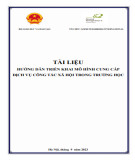
![Tài liệu học tập kỹ năng xã hội môn Kỹ năng học tập bậc đại học [mới nhất]](https://cdn.tailieu.vn/images/document/thumbnail/2025/20250414/trantrongkim2025/135x160/961744604716.jpg)

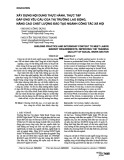
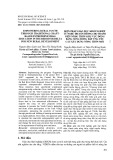
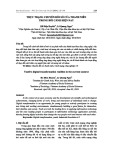
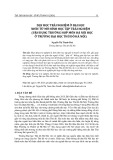


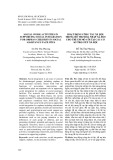


![Sổ tay Hướng dẫn truyền thông về lao động trẻ em [Mới nhất]](https://cdn.tailieu.vn/images/document/thumbnail/2025/20251114/kimphuong1001/135x160/7201763091001.jpg)

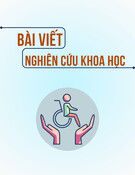





![Cẩm nang Thanh niên hành động [Mới nhất]](https://cdn.tailieu.vn/images/document/thumbnail/2025/20251017/kimphuong1001/135x160/1521760665202.jpg)




